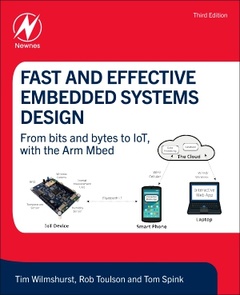Description
Fast and Effective Embedded Systems Design (3rd Ed.)
From bits and bytes to IoT, with the Arm Mbed
Authors: Wilmshurst Tim, Toulson Rob, Spink Tom
Language: English
Subject for Fast and Effective Embedded Systems Design:
560 p. · 19x23.4 cm · Paperback
Description
/li>Contents
/li>Biography
/li>Comment
/li>
Fast and Effective Embedded Systems Design, Third Edition is a fast-moving introduction to embedded systems design, applying the innovative Arm mbed “ecosystem,” including both hardware components and its web-based development environment. Minimal background knowledge is needed to start. Each chapter introduces a major topic in embedded systems and proceeds as a series of practical experiments. A "learning through doing" strategy is adopted, with the underlying theory being introduced alongside. C/C++ programming is applied, with a step-by-step approach which allows you to get coding quickly. Once the basics are covered, the book progresses to some hot embedded topics ? intelligent instrumentation, Bluetooth LE, Zigbee, real-time programming, and the Internet of Things.
In this new edition all code is refreshed to match the new mbed operating system, and much new code is introduced. The principles of real-time operating systems are explained, and the capabilities of the mbed RTOS are clearly demonstrated. This third edition will readily form the basis of introductory and intermediate university or college courses in embedded systems.
Part 1: Essentials of embedded systems, and developing with mbed 1. Embedded systems, microcontrollers and arm 2. Introducing the mbed ecosystem 3. Digital input and output 4. Analog output 5. Analog input 6. Real time, and the mbed real time operating system 7. Starting with serial communications 8. Liquid crystal displays 9. Interrupts, timers and tasks 10. Memory and data management Part 2: Moving to advanced and specialist applications 11. More on the rtos 12. Wireless communication – bluetooth and zigbee 13. Internet communication and control 14. Applying mbed to digital audio 15. Some hardware insights: clocks, power supply, and very low power Appendix a. Some number systems b. Some c/c++ essentials c. Mbed technical data d. Parts list e. Terminal emulation
Tim Wilmshurst has designed numerous embedded and electronic systems, including systems in climatic monitoring, earthquake research, wind tunnels, and autonomous vehicles. He is the author of several textbooks on embedded system design. In his teaching, Tim advocates “learning through doing and problem-based learning. He has been Head of Electrical Engineering at Botswana Polytechnic, Senior Design Engineer at Cambridge University, and Head of Electronics at Derby University. He is now a freelance technical author and educator.
Rob Toulson is a Visiting Professor at the University of Westminster, as well as founder and director of RT Sixty, a company that develops innovative applications for the audiovisual and music industries. His expertise covers a broad range of fields, including mobile application development, digital signal processing, embedded systems, musical acoustics, music production, and interactive sound design.
Tom Spink is a lecturer in computer science at the University of St Andrews. Throughout his research, he has pioneered the use of hardware virtualization support for dynamic binary translation, and he is currently investigating how Internet of Things systems can be efficiently simulated at scale. He is broadly interested in the area of computer systems, and more specifically compilers, runtimes, virtualization, and operating systems.
· Provides a hands-on introduction to the field of embedded systems, covering key concepts through simple and effective experimentation
· Features a wide range of coverage, from simple digital input/output to advanced networking and intelligent instrumentation
· Includes a new chapter on the Real-Time Operating System, with numerous examples
· Introduces two new chapters on the Internet of Things, with a major example project linking sensors through to the cloud
· Presents in-depth exploration of internal microcontroller features, leading to an understanding of configuration options and power supply optimization

